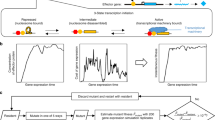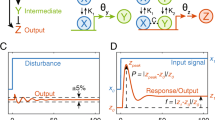Abstract
Feed-forward regulatory loops, where a transcription factor (TF) regulates target gene expression in two ways, directly and through a microRNA (miRNA), are widely involved in gene networks. A feed-forward regulatory loop is termed coherent when its regulatory branches exert similar effects on the target gene and incoherent otherwise. The objective of the study was to understand whether feed-forward regulatory loops are capable of adapting to changes in the number of TF molecules. Two coherent and two incoherent loops were considered using two different models involving different regulatory mechanisms. Coherent loops were found to be incapable of adaptation in contrast to incoherent loops, which demonstrated perfect adaptation within specific parameter sets; i.e., target gene expression was insensitive to variation in TF number. Adaptation of incoherent loops was observed to occur only when a sufficient number of miRNA molecules are available in the system.








Similar content being viewed by others
REFERENCES
H. Heranz and S. Cohen, Genes Dev. 24, 1339 (2010).
N. Bushati and S. Cohen, Annu. Rev. Cell Dev. Biol. 23, 175 (2007).
U. Alon, Nat. Rev. Genet. 8, 450 (2007).
S. Magnan and U. Alon, Proc. Natl. Acad. Sci. U. S. A. 100 (21), 11 980 (2003).
M. A. Duk, M. G. Samsonova, and A. M. Samsonov, BMC Genomics 15 (Suppl. 12), S9 (2014). doi 10.1186/1471-2164-15-S12-S9
M. A. Duk, A. M. Samsonov, and M. G. Samsonova, Biophysics 60 (2), 163 (2015).
W. Ma, A. Trusina, H. El-Samad, et al., Cell 138, 760 (2009). doi 10.1016/j.cell.2009.06.013
L. Goentoro, O. Shoval, M. W. Kirschner, and U. Alon, Mol. Cell 36, 894 (2009).
O. Shoval, L. Goentoro, Y. Hart, et al., Proc. Natl. Acad. Sci. U. S. A. 107 (36), 15 995 (2010).
M. Osella, C. Bosia, D. Cora, and M. Caselle, PLoS Comput. Biol. 7 (3), e1001101 (2010).
ACKNOWLEDGMENTS
We are grateful to A.M. Samsonov, who initiated and encouraged this work, which would be impossible without him. We are additionally grateful to M.G. Samsonova for advice in the biological content of the article.
This work was supported by the Russian Foundation for Basic Research (project no. 17-01-00638a).
Author information
Authors and Affiliations
Corresponding authors
Ethics declarations
The authors declare that they have no conflict of interest. This article does not contain any studies involving animals or human participants performed by any of the authors.
Additional information
Translated by T. Tkacheva
Abbreviations: TF, transcription factor; miRNA, microRNA.
Rights and permissions
About this article
Cite this article
Duk, M.A., Rukolaine, S.A. The Ability of Feed-Forward Regulatory Loops to Adapt: Dependence on Model Parameters and Conditions of Absolute Adaptation. BIOPHYSICS 63, 837–846 (2018). https://doi.org/10.1134/S0006350918060088
Received:
Published:
Issue Date:
DOI: https://doi.org/10.1134/S0006350918060088




